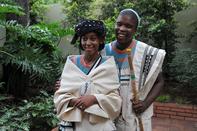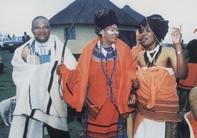Nguni Marriage Rules
Marriage was traditionally exogamous - marital partners were sought outside the kin group, which was a distinguishing trait of the Nguni in general. Every Nguni child is born into a patrilineal clan and marriage within the clan is a heinous offence and strictly prohibited.

Among the Xhosa, who was particularly fastidious in this regard, marriage was avoided with the clans of all four grandparents. Marriage was virilocal, which means that a wife resided with her husband and his people. Marriage was also polygynous, and chiefs and wealthy men with large herds of cattle married more than one wife and, in some instances, had as many as four or more wives.
They were usually distinguished in rank according to different houses. Among the Xhosa, the principal cleavage was between the Great House and the Right-Hand House.
The Great Wife
The Great Wife was responsible for producing the son and heir, the Great Son, who inherited his father's position - chief or household head as the case may be after his father's death. The Great Wife of a chief was usually a woman of rank, the daughter of a chief from a neighbouring chiefdom, a Khoisan or Thembu princess.
A man's Right-Hand Son, the first-born son of the Right-Hand Wife, was also a chief or household head, with his own herds, dependants and followers. However, he was responsible for establishing his own chiefdom or homestead by colonizing new or previously unsettled territory.
Additional wives were attached as rafters or supports 'amaqadi' to the two main houses and were distinguished in rank accordingly. One important consequence of the chief marrying the Great Wife later in life, after contracting other marriages, was that the Great
Son and heir were younger than the older and more experienced Right-Hand Son. This was a source of tension and friction between the two half-brothers. The ensuing rivalry between the Right-Hand Son and the Great Son could result in the former usurping the chieftainship of the latter. Alternatively, it could lead to fission and segmentation within the chiefdom itself.
When a man was monogamous, which was not unusual among commoners, his first wife automatically became the Great Wife and her first-born son the Great Son and heir. A polygamist’s wives each had their own dwellings and economic resources in cattle and grain to maintain their respective households. A chief's Right-Hand Wife usually occupied her own homestead at a distance from the Great Place.
Marriage Negotiations

The transfer of cattle 'ikazi' from the bridegroom's group to the bride's group served both to seal the marriage and compensate the bride's father for the loss of his daughter's labour in his homestead. Marriage negotiations between the two parties could be difficult and protracted, particularly when it came to settling the number of cattle that were to be transferred.
The transfer of cattle also served as a form of insurance: should the bride be mistreated in her new home, she could return to her parent's home, and her husband's group would forfeit the cattle. A man who received cattle in exchange for a marriageable daughter could use the cattle to obtain an additional wife for himself or he might use them to assist a son or kinsman to obtain a wife.
Thus the exchange of cattle in marriage was a form of circulating bridewealth, with women moving in the opposite direction from the cattle. The missionaries, erroneously believing lobola to be the purchase of the bride, condemned the practise on moral grounds. Although marriages are more commonly contracted in church or the magistrate's court nowadays, lobola has not entirely disappeared, even though it is now more likely to be paid in cash equivalent to the market value of the cattle involved in the transaction.
Traditional marriage was not simply a means of formalizing a relationship between members of the opposite sex for the purposes of procreation. More importantly, it was a means of forging alliances between unrelated groups, which is why marriage within the clan was prohibited.
The Bride’s New Normal
After marriage, the bride is effectively a stranger in her new home. She had to show deference and respect 'intlonipho' to her parents-in-law and all senior members of the homestead; she could not approach the houses directly by walking across the courtyard, but had to approach them from behind; she was also not allowed to enter the cattle byre.
A married woman's position within the homestead gradually improved as she had children and they grew up. Menstruating women were considered to be a polluting influence to livestock and were not allowed into the cattle byre. Once they were past menopause, a woman's status was almost on a par with that of men. She was permitted to attend formal beer drinks and sacrifices and to smoke a long-stemmed pipe.